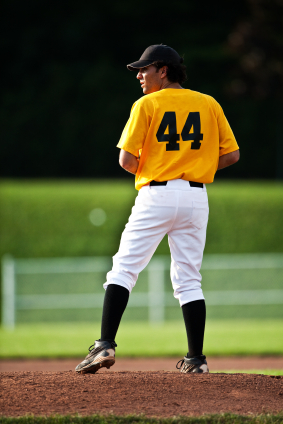Pitching from a mound causes increased stress on the shoulder and elbow of adolescent pitchers as compared with that from flat ground finds a new study, [1] which recommends that pitchers begin their season or return from injury or surgery by starting their pitching progression on flat ground before progressing to the mound.
A previous study of college-aged pitchers by researchers at the American Sports Medicine Institute [2] found kinematic differences at foot contact and ball release when the participants threw from the flat ground versus a mound, and that shoulder and elbow torque in these adult-aged pitchers was greater when performing long throws, especially at a distance of 180 feet. While the study found long-toss throwing in a line from flat ground to be a safe exercise for rehabilitation and training, the high magnitude of elbow and shoulder torque led the authors to recommend against the use of long-toss throwing for maximum distance.
Researchers at the Elite Sports Medicine, Connecticut Children's Medical Center in Farmington, CT wanted to see if the same was true for younger pitchers.
To test the long-held belief that pitching from a mound increases stresses on the shoulder and elbow, they analyzed the fastball pitching motions of 15 adolescent baseball pitchers using a 12-camera video motion system.
They found a small (6%), but statistically significant, increase in internal rotation of the shoulder joint and inward movement of the elbow for all 15 participants when pitching from the mound.
"Understanding the kinematic and kinetic differences*experienced with pitching from a mound or flat ground, said lead author Carl Nissen, M.D. could assist with injury prevention in adolescent pitchers as well as provide a basis for coaching practices."
Noting that the causes of the increased incidence of shoulder and elbow injuiries in adolescent pitchers were likely "multi-factorial," and that such injuries have continue to increase despite steps to reduce the injury risk by instituting pitch limits and requiring days of rest between pitching, Nissen said that the results of the study supported a recommendation that pitchers begin their season or return from injury or surgery by starting their pitching progression on flat ground before progressing to the mound in order to put less stress on their elbow and shoulder.
Flat-ground throwing: rehabilitation staple
Following a shoulder or elbow injury or surgery, a baseball pitcher or position player needs to progress through a multi-phase rehabilitation program to return to competition, beginning with exercises to restore range of motion, followed by more functional and aggressive rehabilitation exercises, such as plyometrics and high-speed training, to prepare the player to throw. [2]
The "hallmark" of the return-to-activity phase of rehabilitation, says Glenn Fleisig, PhD, Research Director of the American Sports Medicine Institute in Birmingham, Alabama, is an interval long-toss throwing program. For skelatally mature players, such a program starts players at a throwing distance of 45 feet and progressively increases it to 180 feet, with players told to use "crow-hop" footwork and throw "on a line" (a hard throw with a low trajectory), and to use proper mechanics. [2]
Pitchers progress during the the flat-ground throwing phases from partial-effort to full-effort pitches before throwing off the mound. In theory, this progression of throwing phases allows an injured athlete to gradually recover his arm flexibility, arm strength, and proper throwing mechanics. [2]
While flat-ground throwing has been part of baseball rehabilitation and conditioning for decades, [2] concerns have recently been raised about whether it might be ineffective or even harmful for baseball pitchers and position players because it requires the pitcher's arm to generate greater force, torque, range of motion, and speed than pitching would, and there has also been controversy over limitations on throwing distances.
Well-done study
While viewing the Nissen study as "well done," Glenn Fleisig, lead author of the ASMI study noted an important difference from his study of college-age pitchers in that the athletes in the Elite Sports Medicine study did flat ground "pitching," not flat ground "throwing" as in their study. "In other words, they were not allowed to take a step or two before throwing."
"Their clinical conclusion to start pre-season or rehab throwing (or pitching) from flat ground," however, "is consistent with their kinetic data and consistent with our 'interval throwing program,'" Fleisig said.
* According to differencesbetween.com, "Kinetics study the motion and the forces that are underlying this motion, kinematics is solely focused on the study of motion and does not take into account any forces that may be acting upon the body in motion."
1. Nissen CW, Solomito M, Garibay E, Ounpuu S, Westwell M. A Biomechanical Comparison of Pitching From a Mound Versus Flat Ground in Adolescent Baseball Pitchers. Sports Health: A Multidisciplinary Approach. 2013;DOI:10.1177/1941738113502918 (epub September 4, 2013).
2. Fleisig GS, Bolt B, Fortenbaugh D, Wilk KE, Andrews JC. Biomechanical comparison of baseball pitching and long toss: Implications for training and rehabilitation. J Orthop Sports Phys Ther. 2011;41:296-303.
Posted September 4, 2013; revised September 10, 2013.








